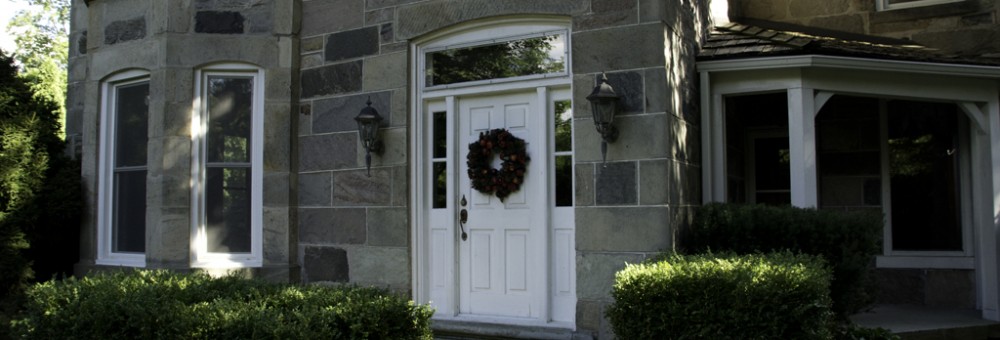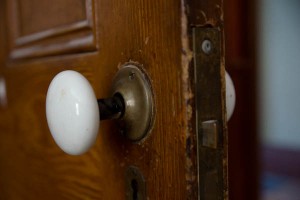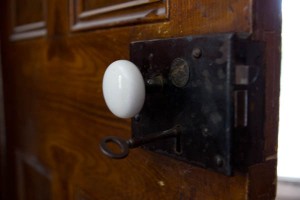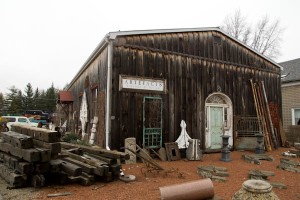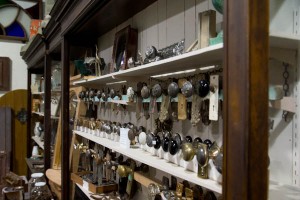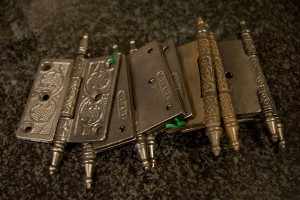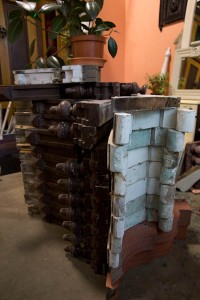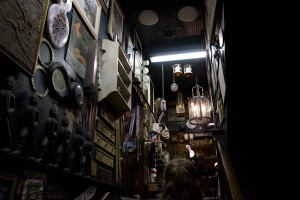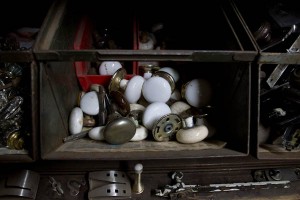Since acquiring Boo Manor, the importance of door hardware – and installing the correct door hardware – has become something of a fetish for me. An odd fetish to be certain, and also not a cheap one.
Seren had done some research, and typically porcelain door knobs would have been used in a house of this era, which makes the motley collection of glass, brass and metal doorknobs oddly inappropriate. And I have already well-documented the quest for appropriate door hinges. My shopping trips through southern Ontario had yielded an impressive collection of porcelain-knob related door hardware from a variety of vintages, but there still remained the challenge of putting it all together and making it work.
Installation was complicated by the fact that we also had a variety of different door vintages to work with. Two of the doors off the dining room were modern, and had the usual two-inch hole for the door handle hardware to be mounted in. This left us with two choices: use modern door hardware, or replace the doors. Replacement was neither practical nor overly cost-effective, so newer door handles were the way to go here. The door to the basement and the outside (because yes, our dining room has an exterior door) are the same age of the house, and use the old-style iron bar through a much tinier door whole. And the door to my den didn’t even exist, which opened up our options on that front quite considerably.
I had, at Addison’s in Toronto, found porcelain doorknobs that looked older but weren’t. In fact, a minimal amount of internet research revealed that they were Australian, made by a company called Gainsborough, and brand new ones could in fact be bought at local hardware stores. The ones that I had purchased had been recovered from a house somewhere in Toronto, and had enough of a patina of age and use as to be plausible in the dining room. The downside was that they also had horribly gaudy fake-brass-rosettes (and Dianne is already planning for the eradication of all brass door hardware from Boo Manor) that certainly don’t count as period.
The doorknobs from Addison’s were new enough, however, that they would work in the mounting holes of the newer doors. Assuming that I had the appropriate door hardware to finish the job. The tubular latch sets (the little pokey-slidey things that go in the side of the door, with the spring loaded doo-hickey that actually holds the door closed) that were there didn’t work with the new doorknobs. And I was a couple of screws short of a mounting solution for them (and no, I don’t need to hear your rude comments about this plight).
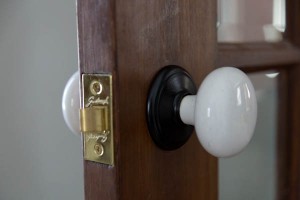
Why Gene has a stockpile of Gainsborough hardware I don’t know, but I’m desperately grateful that he does.
Fortunately, and coincidentally, Gene has in the past made extensive use of Gainsborough doorknobs, and has a box full of old parts, screws, mounting plates and latches (not to mention two brand new doorknob sets, if desperation truly set in) that he was happy to let me graze through. And for reasons that escape me, the box yielded up two tubular latch sets (still in their packaging) that were exactly what I needed to finish off the doors. The brass rosettes got a coat of Tremclad semi-gloss black paint (adding significantly to the fumes that were already wafting about courtesy of the floor refinishing) and I now had two sets of newer doorknobs that looked slightly used and should actually work in the doors.
The doors to the basement and outside were easier to manage, on a relative scale. It had been recommended that the porcelain knob that would be outside be sealed, to help it resist weathering over time, but the installation was mostly straightforward. The basement door just required a replacement of knobs. The exterior door was a slightly different challenge, in that I needed a cross-bar long enough to make it through the door and the surface-mount lockset. By astounding coincidence, however, one of the cross-bars that I had picked up at Addison’s under the mistaken assumption that it would work with the Gainsborough doorknobs was the exact length I needed for the exterior door.
And so, the jigsaw puzzle that has been Project Doorknob has come to a successful conclusion, and we now have five doors in or near the dining room that all have period(ish) porcelain knobs. And I only lost a few brain cells from paint fumes and whatever it was that the floor refinishers were using. I’m calling that a win.
